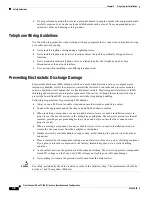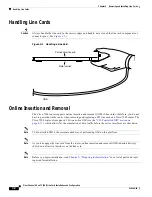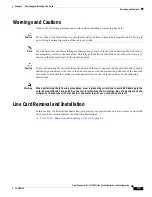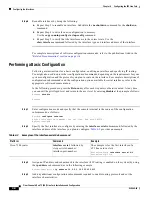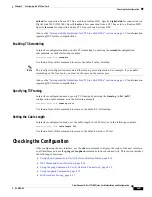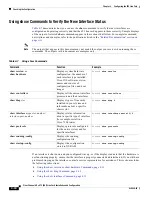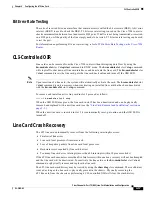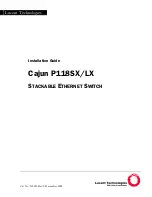
4-8
Clear Channel 6-Port T3 (DS3) Line Card Installation and Configuration
OL-3449-02
Chapter 4 Configuring the 6T3 Line Card
Configuring the Interfaces
CRC is an error-checking technique that uses a calculated numeric value to detect errors in transmitted
data. All interfaces use a 16-bit CRC (CRC-CITT) by default but also support a 32-bit CRC. The sender
of a data frame calculates the frame check sequence (FCS). Before it sends a frame, the sender appends
the FCS value to the message. The receiver recalculates the FCS and compares its calculation to the FCS
from the sender. If there is a difference between the two calculations, the receiver assumes that a
transmission error occurred and sends a request to the sender to resend the frame.
Enable 32-bit CRC using the crc 32 command. Before you can enable 32-bit CRC, you must use the
interface serial command (followed by the interface address of the interface) to select the interface on
which you want to enable 32-bit CRC. This command functions in the same way on all supported
platforms.
In the example that follows, 32-bit CRC is specified:
Router(config-if)# crc 32
The preceding command example applies to all systems in which the 6T3 line card is supported.
Use the no crc 32 command to disable CRC-32 and return the interface to the default CRC-16
(CRC-CITT) setting.
When you have finished, press Ctrl-Z—hold down the Control key while you press Z—or enter end or
exit to exit configuration mode and return to the EXEC command interpreter prompt. Then write the new
configuration to NVRAM using the copy running-config startup-config command.
Note
When enabling a 16-bit or 32-bit CRC on a local interface, ensure that the remote device
is also configured for a 16-bit or 32-bit CRC.
For command descriptions, refer to the Configuration Fundamentals Configuration Guide publication.
For more information, see the
“Obtaining Documentation” section on page viii
and the
“Obtaining
Technical Assistance” section on page x
.
Configuring the Clock Source
The only exception for matching local and remote DS3 port configurations is that the clock sources must
be set opposite each other. Therefore, if you enter the clock source internal
command for the local DS3
port, you must enter clock source line for the remote DS3 port.
Defining the DSU Mode
In interface configuration mode, define the DSU interoperability mode by entering the
dsu mode [adtran | [cisco | digital-link | kentrox | larscom ] configuration subcommand, as in the
following example:
Router(config-if)# dsu mode cisco
Use the no form of this command to return to the default, 0.
Note
The local port configuration must match the remote port configuration. For example, if you define the
DSU interoperability mode as cisco on the local port, you must do the same on the remote port. You need
to know what type of DSU is at the remote port to find out if it interoperates with the 6T3 line card. For
T3 serial interfaces, specify cisco for connection from a 6T3 line card to another 6T3 line card. Specify

